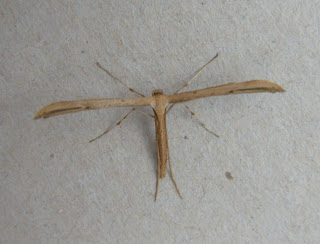A cloudy night was forecast, so out went the trap. I had attracted a Barred Sallow to my porch the night before and given Graham's productive session felt there may be something new in the offing. I was right. Three new species for me, and two new ones for us in the Strettons. Well, sort of, as one of the moths I cannot identify to exact species, but more of that later.
Before I went to bed I checked around the trap and was pleasantly surprised to find a
Grey Shoulder-knot. This was not a moth on my radar, so was a very nice surprise. It is a good looking moth, as I am sure you will agree.
 |
| Grey Shoulder-knot |
When I opened the trap this morning there were another ten moths in the trap. This included the usual suspects, a couple of
Flounced Rustics and four
Lunar Underwings, along with two
Eudonia angustea, which is a micro moth that I regularly catch.
There was also a
Satellite, a moth that Graham has caught a few of in recent weeks, but the first time I have recorded it. I also had an
Epiritta species, a group of moths which includes three very similar species - November Moth, Pale November Moth and Autumnal Moth. Of the three, the November Moth is the most likely to occur, but all are possible and there appears to be some debate as to how easy it is to distinguish the different species. On well-marked individuals the forewing markings can help, whilst males can be identifed through their genitalia when viewed under a hand lens. Alas, my specimen was a poorly-marked female, so it has gone down as
November Moth agg. for my records, unless Graham can shed some more light!
 |
| November Moth agg. |

+Acleris+sparsana.JPG)
+Agonopterix+arenella.JPG)



+on+ragwort.jpg)
+Lithophane+leautieri,+Blair's+Shoulder+Knot.JPG)

+Acleris+variegana+5.JPG)










+Ennomos+fuscantaria,+Dusky+Thorn.JPG)












